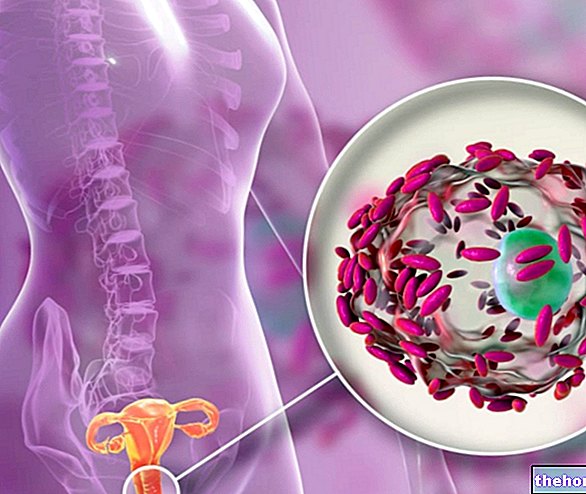Asthma
Asthma is a fairly widespread chronic inflammatory disease, which affects the respiratory tract; the symptoms are quite variable (dyspnoea, cough, chest tightness and difficulty in breathing), but usually they are associated with reversible obstruction of the air flow and bronchospasm.

Diagnosis is usually based on symptoms, response to drug therapy, and spirometry.
Asthma is classified according to the frequency of symptoms, the forced expiratory volume in the first second (FEV1) and the peak expiratory flow (detected with spirometry).
Asthma can also be divided into atopic (extrinsic) and non-atopic (intrinsic), where atopic means the predisposition to the development of allergic reactions (type 1 hypersensitivity); in this type of asthma, it is possible that the incorrect diet exercise a predisposing role.
Pharmacological treatment of acute symptoms occurs by inhalation of beta-2 agonist drugs and orally by corticosteroids; in very severe cases, they can be injected during hospitalization.
Acute prevention requires avoiding the triggering mechanism, for example contact with allergens or irritants; one can choose to make constant inhaled pharmacological use of corticosteroids, sometimes supported by long-lasting beta agonists or antileukotriene drugs.
Worldwide asthma diagnoses have increased significantly since 1970. In 2011, 235-300 million people were recognized as asthmatics and 250,000 died.
Based on what has been said so far, asthma seems to be a disease that affects only the respiratory tract. However, some forms are very affected by certain oral allergenic factors, relative cross-reactivity and other predisposing conditions; some of these affect the etiological mechanism of the bronchus -constriction, others significantly emphasize the complications of the pathology itself.
Asthma and Nutrition in Pregnancy or Lactation
We specify that asthma can have a rather important genetic (hereditary) and family basis, which is why some women tend to make lifestyle changes quite relevant already from conception.
First of all, for disclosure correctness, we remind you that blocking drug therapy increasing the risk of hypoxemia of the fetus (due to poor pathological control or regarding potential serious exacerbations) is considered a very risky attitude. On the other hand, it is advisable to take the usual drugs at minimal doses and in the presence of continuous medical monitoring.
As far as nutrition is concerned, however, there are still many doubts. Many believe that food prevention from asthma begins with pregnancy and breastfeeding. This is why some pregnant women or nurses avoid the intake of potentially allergenic foods. , adopting the so-called "elementary hypoallergenic diet".
On the other hand, no statistical correlation has yet been demonstrated between this nutritional style and the reduction in the incidence of asthma (in the mother or child). Being a highly restrictive diet (potentially subject to nutritional deficiency), almost all doctors suggest not to use it except in the presence of well-determined risk factors (eg familiarity with a particular allergy).
In the nurse, the diet free of potentially allergenic molecules has a much higher value. It serves to avoid contact between the newborn and some allergens that could prove fatal (due to anaphylactic reaction) but, even in this case, it has less to do with the onset of asthma than the more serious pictures of food allergy.
NB. Breastfeeding rather than artificial breastfeeding represents a preventive factor from any disease.
Asthma and Obesity
There was a more than significant correlation between the onset of obesity and the diagnostic incidence (or worsening) of the asthmatic condition (especially in recent years).

- a reduction in respiratory function due to the accumulation of fat
- and the metabolic pro-inflammatory state induced by excess adipose tissue (common to asthma).
Furthermore, the comorbidity between asthmatic disease and severe overweight can be referred to the so-called "Western lifestyle", that is: physical inactivity, few antioxidants and long stay indoors.
Ultimately, obesity represents a non-allergic, predictive and independent factor from the others regarding the onset of asthma.
Asthma and Antioxidants
Another dietary factor that appears to alter the incidence and severity of asthma is the presence of antioxidants.
The group of antioxidants is chemically very heterogeneous; it has the function of limiting oxidative stress by intervening at various levels (based on the specific molecule), but the action of the single element is amplified by that of all the others.
Without going into too much specifics, remember that antioxidants can be endogenous (produced by the organism) and exogenous (taken with food). Obviously, the greater the proportion of molecules introduced with the diet, the higher the defensive level.
In addition to fighting free radicals, antioxidants are able to exert an anti-inflammatory, antitumor, hypocholesterolemic, hypoglycemic, protective action against atherosclerosis, etc.
Antioxidants play a protective role against asthma thanks to their ability to prevent systemic inflammation which, as we have seen in obesity, is involved in the etiology of this disorder.
The most common food antioxidants are:
- Vitamins: provitamin A (carotenoids), vitamin C (ascorbic acid) and vitamin E (tocopherols or tocotrienols)
- Mineral salts: Zinc and Selenium
- Phenolic substances: anthocyanins, flavonoids, flavones, phenolic acids, phenolic alcohols, secoridoids, hydroxyanimidic acids, etc.
- Tannins
- Chlorophyll
- Melanoidins
- Caffeine and the like.
Asthma and Allergens
Almost all allergens are substances naturally present in the environment that enter the body by inhalation, with food or drugs. It is therefore legitimate to deduce that food allergens - in particular those of eggs, milk, nuts and fish - can also determine the onset of asthma.
On the other hand, it has not yet been demonstrated that the allergens present in food have the power to independently trigger asthma-like symptoms.
In "professional asthma (other than the aggravation of a pre-existing form), there is a certain incidence among operators who work in food establishments (production of flour - baker's asthma) or food additives. These forms, together with the other types of occupational asthma, constitute up to 15% of the total.
Asthma and Food Additives
Once again responsible for adverse effects on human health, some food additives have been blamed for triggering respiratory crises (acute dyspnea).
Among these, mainly preservatives and dyes are involved, potentially responsible for bronchospasm.
It seems that poor tolerance or excessive intake of sulphites can induce a broncho-constriction comparable to a real asthma attack; the most harmful forms are those of sodium and potassium metabisulphites, or E223 and E224, used mainly in winemaking.
Not only that, even the azo dye E107 or Yellow 2G can trigger bronchial symptoms similar to the asthmatic state; this synthetic additive is used to color yellow foods such as mayonnaise.
Asthma and Diet
Due to concerns about the side effects of drugs useful in the treatment of asthma, scientific progress has turned towards the search for foods or nutrients capable of controlling the onset and aggravation of asthma.
These dietary interventions are mainly aimed at reducing the global inflammatory response. A 2014 trial entitled “Dietary interventions in asthma” revealed that saturated fatty acids can increase the inflammatory response by activating the “pattern recognition” receptors.

Moreover, the antioxidants that we talked about in the previous chapters can exert anti-inflammatory effects of considerable importance such as, for example, the elimination of free radicals (preventing the activation of certain transcription factors such as NF-kB).
Finally, as anticipated, obesity is able to increase systemic inflammation due to the release of chemical mediators from the adipose tissue.
From what was mentioned in the previous chapters and on the basis of what was specified in the research, it seems clear that a good diet against asthma must have the following characteristics:
- Calories needed to maintain weight or reduce weight (in case it is excessive)
- Increased physical activity desirable (if tolerated)
- Prevalence of unsaturated fatty acids over saturated ones with emphasis on the polyunsaturated intake of the omega-3 group (alpha-linolenic, EPA and DHA)
- Reduction, not only percentage but absolute, of saturated fats
- Increase, not only percentage but absolute, of omega-3 fats
- Rich in antioxidants with anti-inflammatory action such as, for example, those vitamins, minerals and phenolic in nature
- Absence of food additives potentially harmful to asthma.
In practical terms it is possible to state that:
- If the weight is excessive, the asthma diet must promote weight loss in association with a motor activity protocol established with the treating physician and a sports technician.
- Eliminate all fatty cheeses, many of the seasoned ones and fatty meats (which mainly include cold cuts, fresh sausages, bacon, ribs, etc.)
- Prefer white meats and fish; these, if rich in omega-3s, can also be granted with higher fat percentages
- Dress only with extra virgin olive oil or, at most, with other cold-pressed vegetable oils rich in antioxidants, phytosterols and unsaturated fats
- Consume at least 2 servings of vegetables and 2 of fruit per day
- Minimize processed, refined and packaged foods
- Eliminate wines containing sulphites; at the limit, prefer organic or biodynamic.
Bibliography:
- Dietary factors lead to innate immune activation in asthma - Wood LG, Gibson PG (July 2009) - Pharmacol. Ther. 123: 37–53.
- Dietary interventions in asthma - Scott HA, Jensen ME, Wood LG - Curr Pharm Des. 2014; 20: 1003-10.
Other articles on "Diet and Asthma"
- Asthma - Asthma Treatment Drugs
- Asthma
- Bronchial asthma
- Bronchial Asthma - Treatment, Drugs and Prevention
- Asthmatic Crises (Asthma Attacks)
- Anti-asthmatic drugs
- Bronchial asthma - Herbal medicine
















.jpg)











